It’s been dubbed a “green failure”... Multiple social media users and certain tabloids have been sharing the news that Oslo’s new fleet of electric buses has all stopped working due to freezing temperatures. But what really happened?
Is Oslo, one of the world's leading green cities in terms of emissions, currently at a standstill because all of its electric buses have broken down?
Let's take a look.
Allegedly, cold weather in Norway is severely affecting the vehicles’ range and battery life, according to multiple social media users and international tabloids.
"The cold has paralysed the new electric bus fleet in Oslo. That's millions just sitting idle due to -7 to -14 Celcius temperature," tweeted one account.
"Another electric bus failure. They can’t run below -11C! 320 buses taken out of commission," quipped another user.
Other articles claimed more than 140 bus departures have been affected in the Scandinavian capital daily since the start of December.
Many online used the alleged incident to criticise Norway's goal to move away from diesel and petrol engines in the next two years.
What happened? The situation is less dramatic than on social media
Euronews reached out to Ruter, the company that operates the electric buses in Oslo.
In an email, a spokesperson called the allegations “an extreme exaggeration…We cancelled, on average, between 50 and 100 departures, out of more than 4,000 daily departures, for a few days.”
The company did however admit they had a few “challenges with the range of the buses being shorter in cold weather."
"We solved this by changing the charging shifts. And also by fixing the charging infrastructure."
Ruter claims the issues have since been fixed and the fleet of electric buses continues to run as usual.
Why are electric vehicles impacted by the cold weather?
Cold weather impacts both the range of an electric vehicle (EV) - how far it can travel on a single charge - and also the charging time.
"Every single engine system whether it's a battery or living beings like humans, doesn't function well in the cold. Internal combustion engines also have trouble being cranked at low temperatures," explained Anna Stefanopoulou, professor of mechanical engineering at the University of Michigan.
This problem is not only specific to cars. You've probably noticed how fast a phone or laptop loses power in the cold.
The colder the temperature, the slower the reactions in the batteries needed to generate power.
According to Anna Stefanopoulou, at -12 Celsius, a parked EV can lose up to 30-40% of its range before it even starts its route.
About two-thirds of the extra energy consumed is used just to heat the inside of the car so it's comfortable for the driver and passengers.
Electric vehicles are more efficient than gas engines which means they can't draw on heat produced by the motor to warm the inside of the car.
They have to generate heat in other ways, hence using more energy from the battery which means losing in range.
Is it realistic to operate a fleet of electric buses in countries like Norway?
Although the cold does reduce an EV's range and charging speed, Professor Stefanopoulou believes it's all a matter of organisation and planning.
"The buses need to stay plugged in, if possible, early on, before they start the route and stay plugged in overnight. When you do that, the battery can start and operate at this maximum range."
"Then the transit authorities have to either adjust their routes and notify passengers or equip the bus with diesel heaters for these few cold months to make up for the 30% loss in range if they want to maintain a full schedule and their usual routes," explained the battery expert.
But installing diesel engines means going against the zero-emission goal the city of Oslo is striving to achieve by 2024 for all of its public transportation.
Anna Stefanopoulou does admit that the solution is not black and white: "Getting fully decarbonised is not easy and we are working hard on it. But I do think we need to be aware of the improvements while understanding the shortcomings."
"I think this will help us avoid creating adverse publicity against the big effort we are currently putting into electrification," she said.
